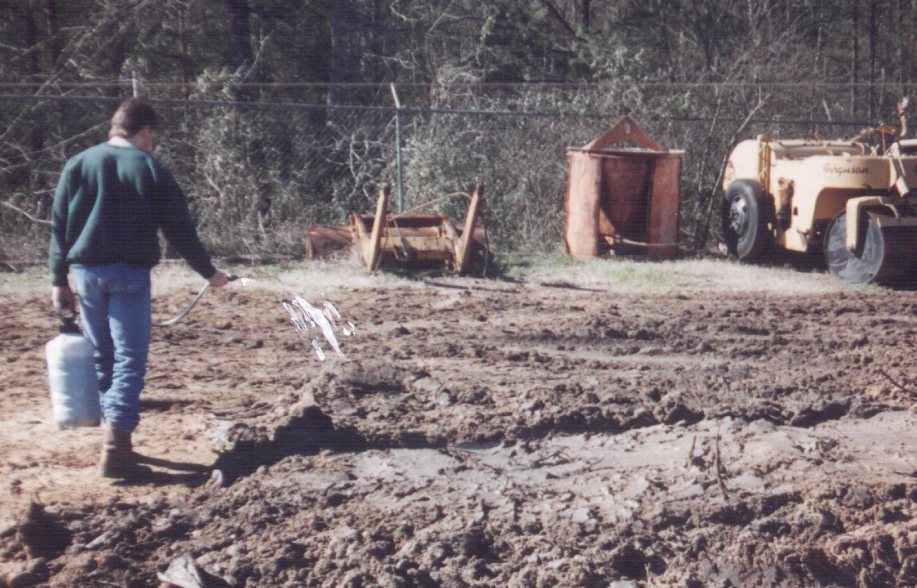
The following briefs or synopses involve some five bioremediation projects, typical of the kinds of bioremediation services ETTL can provide to its clients. One of them, carried out for L&L Asphalt Corporation of Tyler, Texas, reduced stockpiled contaminated soil to a condition acceptable by a Type I municipal landfill. Three of them, carried out at the Texas State Railroad Historical Park, were quite similar to each other, and prepared soil for restoration to the sites involved - though one project also involved bioremediation of portions of a creek and of a pond. The fifth, and perhaps most interesting of the projects, involved restoration of a diesel-impacted creek at a subdivision outside of Tyler.
The L&L Asphalt Corporation Project: ETTL was retained by L&L to help them remediate some 70 cubic yards of contaminated soil to a condition acceptable by a Type I municipal landfill. The soil had been contaminated by heavy petroleum hydrocarbons. Initial readings of samples in February, 1995, showed TPH (total petroleum hydrocarbon) readings as high as 14,000 ppm. The target level for the project was 1500 ppm, which, when reached, would permit the soil to be transported for landfill disposal. ETTL applied mixed microbial cultures that had been multiplied in laboratories at the University of Texas in Tyler to the soil. As an experiment, and because of the relative simplicity of this project, ETTL applied cultures that had originated in the Alaskan environment, on the presumption that their "hardiness" (due to having come from a much more forbidding climate) would enable them to do the job quickly, efficiently, and even more economically, bypassing the usual exploratory research steps. In the above photo, an ETTL environmental scientist sprays a microbe/surfactant/nutrient solution on the contaminated soil. Two such applications were made during the project. In about three months, the soil reached the desired level and was transported to the landfill.
The Texas State Railroad Historical Park Projects: ETTL was retained to sequentially remediate hydrocarbon-contaminated soil taken from three different sites at the Park. The first project involved some 300 cubic yards of soil which, according to TPH readings taken in April, 1995, showed an average of 5000-6000 ppm. The soil, which had been stockpiled, was spread out and treated in much the same way as the soil in the above L&L project. However, ETTL used indigenous petroleum-degrading microbes that were multiplied in the laboratory and applied, with appropriate nutrients and a biodegradable surfactant. In the two subsequent projects, similar quantities of stockpiled contaminated soil at the Park were treated in the same way. In all three cases, the target goal of 500 ppm was reached in a similar time frame, and the soil was restored to the respective sites. In one of the projects, ETTL was also called upon to remediate portions of a creek and a large private pond on an adjacent piece of property, both of which had hydrocarbon contamination along their shores. The same bioremediation solutions were applied, and all impacted soils and properties were cleaned up to everyone's satisfaction.
Bioremediation of a Subdivision's Creek: In this project, ETTL was retained by a contractor doing construction work at a subdivision outside of Tyler. A diesel tank had toppled over during a violent thunderstorm, impacting a creek flowing through the property for about one-third mile. ETTL was called in, and in three days had analyzed the situation and set up a method to remediate both the creek and its banks. Four sets of screens were set up along the course of the creek to hold hay bales in place which would serve as filters for the surface water flowing through. Pipes were laid through the bottoms of these "filter-dams" to let the bottom water, which was clean, flow through unobstructed. The hay bales, as well as the banks of the creek and the surface water itself, were sprayed with microbial/nutrient/surfactant solution. The bales themselves, as they became petroleum saturated, were removed and replaced with clean bales; and the saturated bales were treated with solution and later reinstalled. (The hay bales served not only as filters, but also provided a biomass site for bacterial proliferation.) The over-all arrangement provided a unique and low-cost way to bioremediate the creek, whose water and banks were successfully restored to acceptable levels in less than a month. Only two applications of solution were required. The project was carried out during wintry weather, with temperatures ranging from the mid-30's to mid-50's, attesting to the effectiveness of the bioremediatory approach used.
For further information on these projects and how
ETTL can put its bioremediation capabilities to work
in similar and other types of situations, contact
ETTL's Steve Kennedy
Return to ETTL Bioremediation and Other Site Remediation Services Page
Return to ETTL Environmental Engineering Services Page
Return to ETTL Home Page
Return to Handy Index